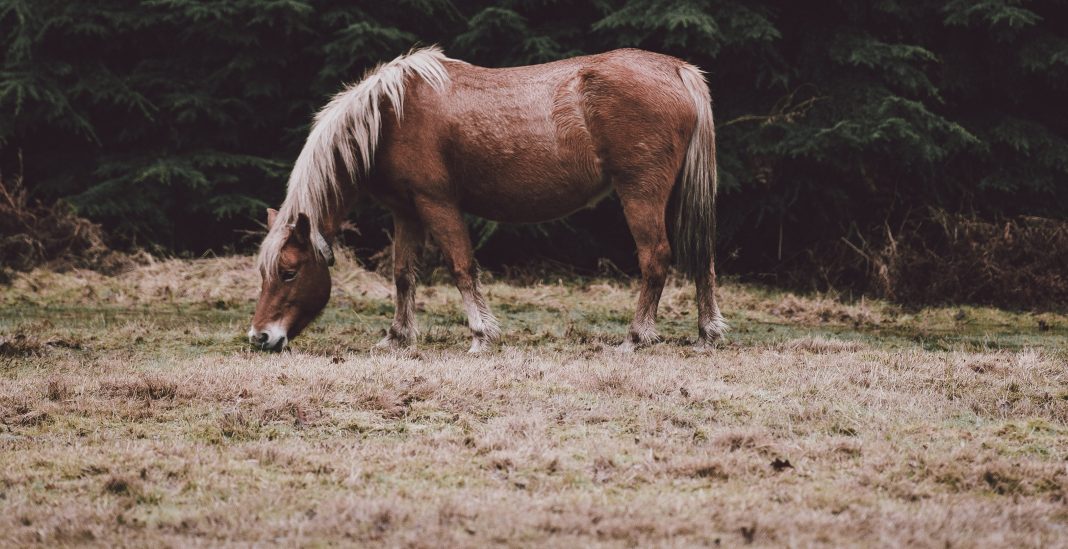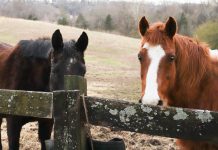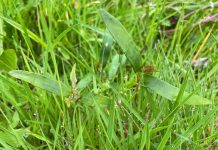UK national pet charity Blue Cross is reminding horse owners to be vigilant about laminitis this autumn. Blue Cross Piglet recently recovered from this crippling and potentially fatal disease, but many horses and ponies are not so lucky.
Laminitis manifests as inflammation and swelling of the tissues within the hoof, resulting in severe pain and potentially irreversible damage. Any horse or pony can be susceptible to the pasture-associated form of the disease, but overweight animals are at higher risk and the seasons during which the grass is growing are the most dangerous.
“The combination of sun and rain that we have been experiencing in most of the UK recently, coupled with many horses still out on summer pasture significantly raises the risk factor for laminitis,” said Clare Bevins, Horse Welfare Supervisor at Blue Cross. “Add to the mix the fact that some owners may still be struggling with their horses’ weight given limitations on riding during the pandemic and potentially we have the perfect storm for laminitis.”
Blue Cross hopes that by highlighting Piglet’s story they can help owners to take action now to keep their horses and ponies safe from laminitis.
Piglet, a six-year-old, 11.2hh obese skewbald mare, suffered a serious bout of laminitis in the autumn of 2018. Her borrower gave the pony two months of box rest and then returned her to the Burford centre in the November for specialist veterinary and farriery treatment.
X-rays showed pedal bone rotation in both of Piglet’s front feet, which would need to be corrected with remedial farriery. Initially her feet were trimmed every two weeks, daily pain relief was given to make her more comfortable and then Styrofoam foot pads were fitted to provide extra support.
The pony was also placed on a strict weight loss programme with a diet of hay amounting to 1.5% of her bodyweight, divided into 3-4 feeds throughout the day, together with a daily ration of balancer to supply essential nutrients. Over the first four months of box rest she lost 21kg, dropping from a body condition score of 5 (obese) to a perfect 3.
For the next two months Piglet was comfortable enough to be turned out for short periods on a soft surface. Six months after returning to Blue Cross X-rays showed that both front pedal bones looked normal. She has now been rehomed as a lead rein pony with a family who are very experienced with managing laminitics.
“Despite being our perfect pony Piglet does have a never-ending appetite,” said her borrower Ri Kirk. “We are very strict about rationing her grazing and feed and we turn her out using a track system to help her ‘self-exercise’.
“We soak hay for 12 hours and hang it in a trickle feeder net from a tree, so it takes longer to eat it and entertains her for longer. She has a workout 4-5 times a week: with lead rein rides and in-hand hacks from my riding horse Rio and sometimes we lunge or free-school her in the round pen. She enjoys TREC-style obstacle courses and has even been known to join the odd dog walk just to burn off some calories! Piglet really is an absolute superstar, she’s kind, gentle and has unending patience with her mini humans.
“Piglet was one of the fortunate ones – her laminitis was caught early and immediate steps taken to treat the disease under the supervision of a vet and a remedial farrier,” said Clare. “Prevention of laminitis is always better than a cure: follow these tips from Blue Cross to help keep your horse or pony safe from this terrible disease.”
- Restrict grass intake by using electric tape to strip graze. Ponies can survive on very little. Grass is very high in soluble carbohydrates (fructans), which can lead to laminitis if ingested in large amounts, especially in spring and autumn.
- Turning a horse out at night and bringing it in during the day can help as there are less fructans in the grass at night.
- Do not turn a horse out on lush or frosted grass.
- Try to work with the landowner to decrease the sugary ryegrasses and clover in the sward and allow more traditional grasses and herbs to flourish.
- Turn out a group of ponies that need the same management together. This will minimise stress, keep them occupied and allow them to carry out normal behaviours whilst still being restricted.
- Monitor your horse’s diet carefully and remember to feed in accordance to workload and type. Dieting ponies and horses should be given around 1.25-1.5 per cent of their body weight in food – this includes any grass and hay intake.
- Follow the rule of feeding little and often. This mimics the horse’s natural feeding pattern and will help keep the digestive system working correctly. It will also satisfy the horse’s need to chew and prevents boredom.
- Never starve a horse or pony as this can lead to serious health problems such as hyperlipaemia and only feed high fibre, low carbohydrate and low sugar products
- Maintain a good exercise programme to prevent obesity.
- Ensure a farrier attends every four to five weeks, to keep your horse’s feet in optimum condition.
- Check the horse’s digital pulses daily as changes can then be detected quickly and the appropriate action can be taken.











